










WAYNE KARL EDITOR-IN-CHIEF Condo Life Magazine
EMAIL: wayne.karl@nexthome.ca
TWITTER: @WayneKarl
When the Bank of Canada held its overnight lending rate at 2.75 per cent in April (after six consecutive reductions beginning last summer), and then again in June, many housing and economics experts raised an eyebrow. With all the uncertainty caused by the tariff discussion with the U.S. adding to the pre-existing apprehension in the real estate market, a rate drop would have been more than welcomed news.
BoC thought otherwise, though, citing the need to “gain more information about both the path forward for U.S. tariffs and their impacts.”
We’re now seeing some of the effects of this decision. According to the latest Royal LePage House Price Survey and Market Forecast, the spring market – typically the busiest time of year for homebuying and selling – was subdued in several regions this year, namely in Toronto and Vancouver, two of the country’s largest and most expensive markets. Amid global political and economic uncertainty, homebuyers continued to take a cautious, waitand-see approach, the realty firm says.
“Homebuyers approached the start of the 2025 spring market with hesitation, dampening what is typically the busiest season on the real estate calendar,” says Phil Soper, president and CEO of Royal LePage. “With trade disputes, a federal election and international conflicts dominating headlines through the first half of the year, many prospective buyers chose to wait. Yet, market fundamentals remain sound; interest is strong while activity is subdued, reflecting the uncertainty weighing on consumer sentiment. Encouragingly, June’s robust employment report may help rebuild confidence and bring more buyers off the sidelines in the months ahead.”
There are further encouraging signs. “With borrowing costs stable and inventory levels continuing to build, the foundation is in place for a stronger market this fall – and signs of renewed confidence are beginning to emerge,” adds Soper.
More locally, Toronto Regional Real Estate Board Chief Information Officer Jason Mercer says, “Additional interest rate cuts would make monthly mortgage payments more comfortable for average GTA households. This could strengthen the momentum experienced over the last few months and provide some support for selling prices.”
So, can we bank on BoC implementing a much-needed rate reduction during its next announcement on July 30? Perhaps we shouldn’t go that far, but all signs point to the likelihood. And with healthy longer term fundamentals in place, we can hope for stronger market performance beginning in the fall.














An award-winning interior designer, Mariam Aboutaam is Director, Sales and Marketing, Interior Design at Kylemore, Markham, Ont., a builder known for master-planned communities and luxury homes. kylemoreliving.com.
Jesse Abrams is Co-Founder at Homewise, a mortgage advisory and brokerage firm based in Toronto. thinkhomewise.com
Elechia Barry-Sproule is President of the Toronto Regional Real Estate Board (TRREB) and Broker/Owner of Red Apple Real Estate Inc. She is committed to mentoring and supporting real estate professionals across the industry. trreb.ca.
Mike Collins-Williams, RPP, MCIP, is CEO West End Home Builders’ Association. westendhba.ca.
Debbie Cosic is CEO and founder of In2ition Realty. She has overseen the sale of more than $15 billion worth of real estate. With Debbie at its helm, In2ition has become one of the fastest-growing and most innovative new home and condo sales companies. in2ition.ca
Barbara Lawlor is CEO of Baker Real Estate Inc. A member of the Baker team since 1993, she oversees the marketing and sales of new home and condominium developments in the GTA, Vancouver, Calgary and Montreal, and internationally in Shanghai. baker-re.com
Linda Mazur is an award-winning, nationally publicized designer and Principal of Linda Mazur Design Group. With almost two decades of experience this in demand multi-disciplinary design firm is known for creating relaxed, stylish spaces and full-scale design builds within Toronto, the GTA and throughout Canada. lindamazurdesign.com @LindaMazurGroup
Ben Myers is the President of Bullpen Consulting, a boutique residential real estate advisory firm specializing in condominium and rental apartment market studies, forecasts and valuations for developers, lenders and land owners. Contact him at bullpenconsulting.ca and @benmyers29 on Twitter.
Dave Wilkes is president and CEO of the Building Industry and Land Development Association (BILD), the voice of the home building, land development and professional renovation industry in the GTA. For the latest industry news and new home data, follow BILD on Twitter at @bildgta or visit bildgta.ca
æ Sign up to receive digital editions & newsletters to your inbox!
Official Media Partners:

SENIOR VICE-PRESIDENT, SALES, NEXTHOME Hope McLarnon 416.708.7987 hope.mclarnon@nexthome.ca
SENIOR MEDIA CONSULTANT Amanda Bell 416.830.2911 amanda.bell@nexthome.ca
EDITORIAL DIRECTOR Amanda Pereira
EDITOR-IN-CHIEF – GREATER TORONTO AREA
Wayne Karl wayne.karl@nexthome.ca
CONTRIBUTORS
Mariam Aboutaam, Jesse Abrams, Elechia Barry-Sproule, Mike Collins-Williams, Debbie Cosic, Barbara Lawlor, Linda Mazur, Ben Myers, Dave Wilkes
EXECUTIVE MEDIA CONSULTANTS
Jacky Hill, Michael Rosset
VICE-PRESIDENT, MARKETING – GTA Leanne Speers
MANAGER CUSTOMER SALES/SERVICE
Marilyn Watling
SALES & MARKETING CO-ORDINATOR Gary Chilvers
BUSINESS DEVELOPMENT MANAGER Josh Rosset
DISTRIBUTION distributionteam@nexthome.ca
ACCOUNTING INQUIRIES
accountingteam@nexthome.ca
DIRECTOR OF PRINT MEDIA
Lauren Reid–Sachs
VICE-PRESIDENT, PRODUCTION – GTA Lisa Kelly
PRODUCTION MANAGER – GTA Yvonne Poon
GRAPHIC DESIGNER & PRE-PRESS COORDINATOR Hannah Yarkony
Published by nexthome.ca
Advertising Call 1.866.532.2588 ext. 1 for rates and information. Fax: 1.888.861.5038
Circulation Highly targeted, free distribution network aimed at real estate buyers using street level boxes, racking and Toronto Star in-home delivery.
Canadian subscriptions 1 year = 13 issues – $70 (inc. HST). Canada Post – Canadian Publications Mail Sales Product Agreement 40065416.
Copyright 2025 All rights reserved. All copyright and other intellectual property rights in the contents hereof are the property of NextHome, and not that of the individual client. The customer has purchased the right of reproduction in NextHome and does not have the right to reproduce the ad or photo in any other place or publication without the previous written consent of NextHome.
Editorial Submissions from interested parties will be considered. Please submit to the editor at editorial@nexthome.ca.
Terms and Indemnification
Advertisers and contributors: NextHome is not responsible for typographical errors, mistakes, or misprints. By approving your content and/ or submitting content for circulation, advertisers and contributors agree to indemnify and hold harmless NextHome and its parent company from any claims, liabilities, losses, and expenses (including legal fees) arising out of or in connection with the content provided, including but not limited to any claims of copyright infringement, unauthorized reproduction, or inaccuracies in the content. Advertisers acknowledge that they have the necessary rights, permissions, and licenses to provide the content for circulation, and they bear full responsibility for the content’s accuracy, legality, and compliance with applicable laws upon approval. Contributors acknowledge NextHome reserves the right to omit and modify their submissions at the publisher’s discretion.
According to the latest Royal LePage House Price Survey and Market Forecast, the aggregate price of a home in Canada eased upwards modestly in the second quarter of 2025, increasing 0.3 per cent yearover-year to $826,400. On a quarterover-quarter basis, the national aggregate home price decreased by 0.4 per cent.
The start of the spring market –typically one of the busiest times of year for homebuying and selling – was subdued in several regions this year, namely in Toronto and Vancouver, two of the country’s largest and most expensive markets. Amid global political and economic uncertainty, many homebuyers continued to take a cautious, wait-and-see approach. The Bank of Canada also held back, maintaining its overnight lending rate at 2.75 per cent during its scheduled April and June announcements, citing the need to “gain more information about both the path forward for U.S. tariffs and their impacts.” Sellers, on the other hand, continue to actively list their homes for sale despite lower than normal activity.
“Homebuyers approached the start of the 2025 spring market with hesitation, dampening what is typically the busiest season on the real estate calendar,” says Phil Soper, president and CEO of Royal LePage. “With trade disputes, a federal election and international conflicts dominating headlines through the first half of the year, many prospective buyers chose to wait. Yet, market fundamentals remain sound; interest is strong while activity is subdued, reflecting the uncertainty weighing on consumer sentiment. Encouragingly, June’s robust employment report may help rebuild confidence and bring more buyers off the sidelines in the months ahead.”
According to a recent Royal LePage survey, conducted by Burson, 28 per cent of Canadians who currently rent
say that, before signing or renewing their current lease, they considered buying a property rather than renting. When asked what factors influenced their decision to rent instead, 40 per cent of respondents said they are choosing to wait for property prices to decline; 29 per cent are choosing to wait for interest rates to decrease further; and 28 per cent say they are working towards buying a property, and continuing to rent allows them to save for a sufficient down payment.
The Royal LePage National House Price Composite is compiled from proprietary property data nationally and regionally in 64 of the nation’s largest real estate markets. When broken out by housing type, the national median price of a singlefamily detached home increased 1.1 per cent year-over-year to $870,200, while the median price of a condominium decreased 0.8 per cent to $592,000. On a quarter-overquarter basis, home prices continued flat, with the median price of a singlefamily detached home increasing just 0.2 per cent, and the median price of a condominium decreasing a modest 1.0 per cent.
“With borrowing costs stable and inventory levels continuing to build, the foundation is in place for a stronger market this fall – and signs of renewed confidence are beginning to emerge,” says Soper. “After a market slowdown, there’s always the risk that a sudden surge in demand could reignite uncomfortable levels of house price inflation. But, unlike previous cycles, inventory is higher than recent norms, which should help absorb returning demand and keep price appreciation in check. This makes for a healthier, more balanced recovery as buyers come back into the market.”
Royal LePage is forecasting that the aggregate price of a home in Canada will increase 3.5 per cent in the fourth quarter of 2025, compared to the same quarter last year. The previous
forecast has been revised down modestly to reflect slower-than-usual sales activity in Ontario and British Columbia. Nationally, home prices are forecast to see modest appreciation throughout the remainder of the year, with sharper gains expected in the fall.
The aggregate price of a home in the GTA decreased 3.0 per cent year-over-year to $1.15 million in the second quarter of 2025. On a quarterly basis, the aggregate price of a home remained relatively flat, increasing 0.8 per cent.
Broken out by housing type, the median price of a single-family detached home decreased 1.2 per cent year-over-year to $1.44 million in the second quarter of 2025, while the median price of a condominium decreased 5.6 per cent to $699,700.
In the city of Toronto, the aggregate price of a home decreased 5.2 per cent year-over-year to $1.15 million in the second quarter of 2025, while the median price of a single-family detached home decreased 4.7 per cent year-over-year to $1.67 million, and condominiums decreased 5.0 per cent to $675,800.
Royal LePage is forecasting that the aggregate price of a home in the GTA will increase 2.0 per cent in the fourth quarter of 2025, compared to the same quarter last year.


Ownership housing affordability continued to improve in June, as average selling prices and borrowing costs remained lower than last year’s levels, according to the Toronto Regional Real Estate Board (TRREB). However, despite some month-over-month momentum, many would-be homebuyers remained on the sidelines due to economic uncertainty.
“The GTA housing market continued to show signs of recovery in June,” says TRREB President Elechia Barry-Sproule. “With more listings available, buyers are taking advantage of increased choice and negotiating discounts off asking prices. Combined
with lower borrowing costs compared to a year ago, homeownership is becoming a more attainable goal for many households in 2025.”
GTA realtors reported 6,243 home sales through TRREB’s MLS system in June 2025 – down by 2.4 per cent compared to June 2024. New listings amounted to 19,839 – up by 7.7 per cent year-over-year.
On a seasonally adjusted basis, June home sales increased monthover-month compared to May 2025. New listings declined compared to May. The monthly increase in sales coupled with the monthly decline in new listings continued the tightening trend experienced during the spring.
The MLS Home Price Index Composite benchmark was down by 5.5 per cent year-over-year in June 2025. The average selling price, at $1.10 million, was down by 5.4 per cent compared to June 2024. On a month-over-month seasonally adjusted basis, the MLS HPI Composite and average selling price both edged lower compared to May 2025.
“A firm trade deal with the United States, accompanied by an end to cross-border sabre rattling, would go a long way to alleviating a
weakened economy and improving consumer confidence,” says TRREB Chief Information Officer Jason Mercer. “On top of this, two additional interest rate cuts would make monthly mortgage payments more comfortable for average GTA households. This could strengthen the momentum experienced over the last few months and provide some support for selling prices.”
“It is important to highlight that housing is not just impacted by economic and financial issues,” adds TRREB CEO John DiMichele. “Canadian residents, both homeowners and renters alike, are increasingly having to deal with the nightmare of violent home invasions and carjackings.
“TRREB is encouraged by the recent federal announcement to table a crime bill this fall introducing stricter bail conditions and sentencing for these disturbing crimes,” he says. “While this is a good first step by the federal government to strengthen public safety, more is needed, such as working with provinces to increase law enforcement funding and improve capacity and efficiency in the court system.”

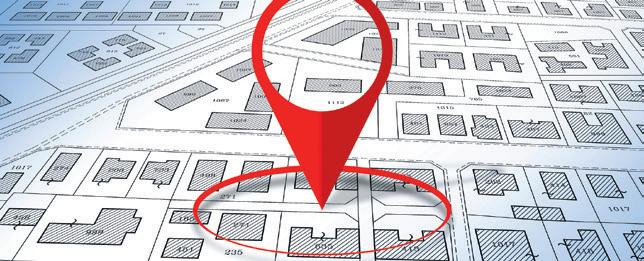
What matters to you?
When it comes to buying a home, what matters most to you? A detached home on a nice lot with the proverbial white picket fence? Condo in a central location close to desired amenities? Proximity to transit, work and schools? A new report underlines just how shoppers’ desires are changing.
2025 BILD Awards celebrate homebuilding excellence in GTA
The Building Industry and Land Development Association recently recognized excellence in the design, construction, marketing and sales of new homes in the GTA at its 2025 BILD Awards Gala.

Future-proofing your investment:
What Toronto’s top architects reveal about the GTA condo market
As a residential housing analyst and podcast host, Ben Myers has crunched the numbers and filled in the data gaps by engaging some of the region’s most prominent developers, lenders and brokers. He recently hosted three of Toronto’s most prominent architects to discuss what the future holds for the GTA new condominium market.

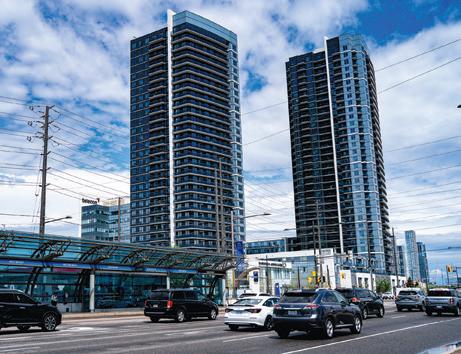
Transit and housing boost appeal and affordability: ReMax Canada
Greater Toronto and Greater Vancouver are experiencing population growth of more than three per cent annually, and significant infrastructure investments, especially in transportation, are leading to improved neighbourhood quality across traditionally undervalued urban and suburban areas, according to the Next Neighbourhoods Report from ReMax Canada.

Inventory is growing, rates are easing… is now a good time to buy?
As homebuyers across Canada wait and wonder, a quiet shift is underway. After years of bidding wars, record-low listings and rising interest rates, the 2025 housing market looks a little different. Across major markets, inventory is climbing, sellers are adjusting and interest rates have begun trending downward. Is now finally a good time to buy?
Visit nexthome.ca



If you’ve been reading recent headlines about Toronto’s housing market, you’ve probably seen terms such as “glut,” “oversupply” and “plunge.” Media reports have focused heavily on unsold inventory in the Greater Toronto Area’s (GTA) new housing market, creating the impression that there’s too much
product and not enough demand. But the reality is more nuanced – and for informed buyers, it might just be a window of opportunity.
Let’s start with an important clarification: A large portion of what’s considered “unsold” doesn’t physically exist yet. Much of it is pre-construction. Developers often release floorplans and pricing years before shovels hit the ground, aiming to hit a sales threshold – typically 70 per cent – before they can secure financing and start building. If they don’t reach their targets, they may delay or cancel the project entirely.
So, while a project might show hundreds of “unsold” units, that doesn’t mean hundreds of finished homes are sitting empty. It means they haven’t started construction and may never proceed unless the economics improve.
That brings us to the current opportunity. Right now, there are more units available than in recent years, and sales activity is subdued. As a result, buyers have more leverage than usual. Developers are more open to incentives, extended deposit structures, and even some minor price flexibility. This is what we mean

when we say it’s a buyer’s market. The balance of power has shifted – at least temporarily.
But that won’t last forever.
Why? Because developers don’t have infinite patience or funding. If units don’t sell, they often get rented out. In fact, many completed buildings in the GTA with slow absorption are now leasing units directly to tenants. Developers with deep pockets and in-house property management teams are happy to generate cash flow and wait until market conditions improve. Once those units are rented, they effectively leave the inventory pool – and the opportunity to negotiate disappears.
This strategy is becoming more common. A decade ago, I conducted a survey of GTA developers that showed that nearly a quarter would consider renting out unsold inventory before dropping prices. Only 12 per cent said they’d reduce prices outright. Conditions are worse than in 2015, but the results are worth considering anyways. Unlike individual sellers in the resale market, developers have specific cost structures. They can’t just lower prices dramatically and absorb the loss. Land was acquired at peak values, and costs for construction, labour, fees and financing were calculated during the era of nearzero interest rates. Even with some cost moderation recently, the margin for many projects has been cut dramatically, limiting room for discounting.
It’s also important to remember that much of the “decline” in rental prices being reported doesn’t reflect widespread weakness. Rental rates for the smallest units – particularly micro one bedrooms or studios –have softened. But for larger, more generously sized homes, pricing remains stable or even slightly higher in some cases. From 2021 to 2023, rents in many GTA submarkets increased by more than 30 percent. A recent five-per-cent dip needs to be viewed in that broader context. We’re seeing a market that’s recalibrating –not collapsing. Some developers are happy to rent the units out, as they’re not impacted by media headlines aimed at generating clicks, not informing buyers and tenants.
Despite the short-term listings bump, new housing supply remains heavily constrained over the long term. Even with today’s record completion levels, strong population growth and limited ground-oriented development continue to place upward pressure on prices. Data from Canada Mortgage and Housing Corp. data shows that new condominium projects are still completing at very high absorption rates, with more than 99 per cent of inventory sold on average in the 12 months ending May 2025.
It’s also worth noting that unsold inventory isn’t evenly spread across the region. A small number of projects – and developers – account for most of the available supply. Large, wellcapitalized firms are content to wait.
Many have already shifted to rental strategies, and their units are being leased – not left empty.
So, what should buyers take from all this?
If you’re in the market for a new home, you currently have rare negotiating power. More supply, slower sales and a quiet summer market mean you can shop around, compare incentives and find value. But the clock is ticking. Developers are already converting unsold units to rentals, and if interest rates drop further, immigration levels jump or employment increases, you’ll see demand return quickly. When that happens, today’s options may no longer be available – or affordable. In short, this is a unique window for well-informed buyers. Yes, there is inventory. Yes, some of it is negotiable. But no, the market isn’t collapsing. The best deals will go quietly, to those paying attention. So do your research, surround yourself with an experienced team and good luck. +MORE CONTENT ONLINE nexthome.ca
Ben Myers is the President of Bullpen Consulting, a boutique residential real estate advisory firm specializing in condominium and rental apartment market studies, forecasts and valuations for developers, lenders and land owners. Contact him at bullpenconsulting.ca and @benmyers29 on Twitter.
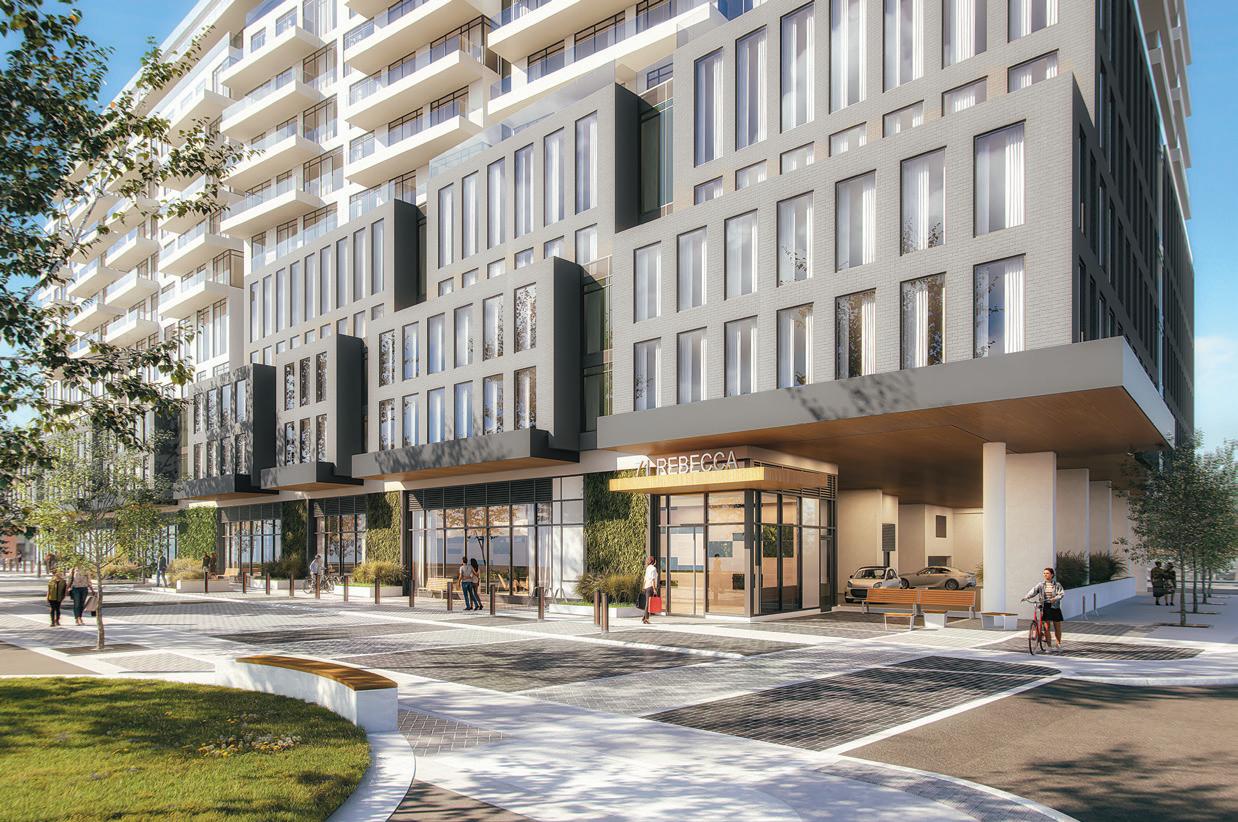
Rosehaven Homes has built more than homes – it has built communities designed to elevate everyday living. With more than three decades of experience, every home the company delivers stands as a promise of enduring quality, thoughtful design and better living.
THE REBECCA – DOWNTOWN LIVING WITH DESIGNER FLAIR NOW SELLING IN HAMILTON
In the heart of downtown Hamilton, The Rebecca is a striking new condo residence offering exceptional value, modern style
and vibrant city living – with suites starting from the $400s.
This contemporary midrise building puts you at the centre of Hamilton’s cultural scene – just steps from restaurants, cafes, galleries, transit and more. Thoughtfully designed suites feature smart layouts, large windows, premium finishes and access to boutique amenities, including a fitness centre and rooftop terrace.
With limited-time incentives available – including no GST (see sales representative for details) – The Rebecca is a rare opportunity for first-
time buyers, young professionals and investors to own in one of Ontario’s fastest-growing cities.
Visit the presentation centre at 212 King William St., Hamilton, call 905.529.8383 or email rebeccacondos@rosehavenhomes.com.
SIMCOE WOODS – A NATURAL RETREAT WITH URBAN ACCESS NOW SELLING IN INNISFIL
Escape the city without leaving behind convenience. Simcoe Woods in Innisfil is a charming community of 20-ft. freehold towns, 33- and 39-ft. singles – with prices starting from
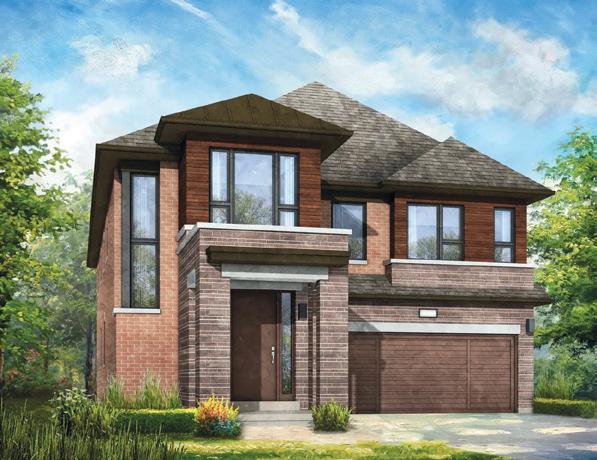
the $700,000s – located just five minutes from the sparkling shores of Lake Simcoe.
This thoughtfully planned neighbourhood offers a serene lifestyle surrounded by parks, walking trails and greenspaces, while remaining well connected to urban conveniences. Enjoy the local shops, restaurants and waterfront attractions of Alcona, with quick access to Hwy. 400 and the proposed Innisfil GO Station ensuring you’re never far from Toronto or the rest of the GTA.
Whether you’re enjoying a day at the beach, spending time in your newly designed home or discovering local gems, Simcoe Woods gives you the freedom to live at your pace – all while enjoying Rosehaven quality every step of the way.
The presentation centre and model home is located at 2153 Donnelly Cres., Innisfil. Call 249.388.8561 or email simcoewoods@rosehavenhomes.com.
NOW SELLING IN OAKVILLE
Oakville has always been a place of distinction – from the grandeur of its lakeside estates to the charm of its downtown boutiques and the convenience of its rapidly expanding uptown core. Now, in the heart of North Oakville, Ivy Rouge continues this legacy of prestige.

Located at Sixth Line and Burnhamthorpe, Ivy Rouge is a sophisticated new community of singles, semis and freehold townhomes starting from $1.1 million. Now in its highly anticipated third phase, every home here is a showcase of timeless architecture, elegant design and thoughtful functionality – built with the unparalleled craftsmanship that has made Rosehaven Homes a trusted name in homebuilding for more than 30 years.
Enjoy an abundance of nearby amenities, from high-ranking schools and major retail centres to trails, parks and golf courses. Ivy Rouge places you in the centre of Oakville’s best –an ideal setting for growing families, working professionals and those seeking both luxury and lifestyle in one address.
Visit the presentation centre at 310 Randall St., Oakville, call 905.844.8795 or email ivyrouge@rosehavenhomes.com.
Set against the backdrop of Caledon’s rolling countryside, The Mayfield Collection is a refined offering of spacious singles on expansive lots, starting from $1.3 million. Located just north of Brampton, this community blends
the tranquility of rural living with the conveniences of urban life.
Here, tree-lined streets and elegant home designs define the streetscape. Inside, open-concept layouts, designer kitchens and luxurious finishes come standard – a testament to Rosehaven’s commitment to exceptional quality and livability.
With nearby amenities, including shopping centres, schools, parks and easy connections to major highways, The Mayfield Collection offers the best of both worlds – countryside calm and city convenience. It’s prestige living, perfected.
The presentation centre and model homes are located at 22 Stratford St., Caledon. Call 905.216.1163 or email mayfieldcollection@rosehavenhomes.com.
Find the home that’s right for you. Learn more at rosehaven.com.


A few years ago, buying into a new development was a race. People lined up overnight, units sold out in minutes and many buyers felt lucky just to get in. But times have changed. The market has slowed, buyers are more cautious and developers are working harder to win trust.
If you’re looking to buy into a new development project today, this shift is actually a good thing. More time, more options and more power to make the right decision – not just a fast one.
If you are selling a new development home in the current market, you need to be listening, connecting and understanding what the buyers actually care about.
In the past, a lot of decisions were based on price-per-square-foot, but that number doesn’t tell the whole story. Today’s best homes are “smart-sized,” meaning they’re designed around real daily life, not just measurements. A smartly laid-out 600-sq.-ft. unit can feel better than a 700-sq.-ft. one with poor flow.
“We need to stop treating homes like paper,” says Winson Chan, vicepresident of sales development at Tridel. “It’s time to get back to the fundamentals of selling a home and it starts by listening and telling a more vivid story. We need to focus on delivering ‘homes.’ Livable spaces that fit people’s lifestyles and offer a level of customization that allows them to make it feel personal.”
Gone are the days when people bought a new development home off a brochure just as an investment. That means they are thinking about things such as proximity to transit, the quality of construction, surrounding community and how the space will serve them over time.
Jean Openshaw, vice-president of sales at Bosa Properties, points out that they deeply consider customer needs when designing homes. “To support evolving lifestyles, we integrate living spaces with thoughtful amenities that foster connection and wellness, like co-working spaces, fitness centres and rooftop gardens, in vibrant neighbourhoods near transit, parks and retail.”
Whether you’re selling or buying, the most successful projects are the ones built around people. Flashy marketing and high-end amenities don’t mean much if they don’t align to what buyers actually need.
Kayleigh Johnson, director of marketing at Peterson, explains it clearly: “You can’t rely on just a goodlooking brand anymore. You have to truly understand your audience –what they need and what they aspire to. The magic happens when that insight drives everything from product to messaging.”
Trust is everything when it comes to buying pre-construction. You’re buying something that doesn’t exist yet, which makes the track record of the developer incredibly important. How many homes have they delivered? Are they known for

finishing on time? What do past buyers say?
Developers such as Tridel and Bosa Properties have built strong reputations for delivering what they promise. And in this market, that kind of track record matters more than ever.
Sales teams today need to take a more consultative approach. There is a lot of product choice out there, so hosting information sessions to answer the important questions such as timelines, deposit structure and everything in between, is key.
The bottom line? The market may have changed, but it has presented an opportunity to get back to the basics and the fundamentals of selling a home.
Tim Ng is the founder and CEO of ADHOC STUDIO and BLACKLINE, pioneering industry-leading digital solutions that merge real estate, art and technology to transform the sales experience. To explore ADHOC’s award-winning renderings and BLACKLINE’s innovative sales platform, visit adhocstudio.ca and blacklineapp.com.


JESSE ABRAMS

Buying your first home is a huge milestone, and a massive financial decision. In today’s market, where affordability is tight and rules are shifting, it’s more important than ever to understand the mortgage process clearly. Many first-time buyers unknowingly fall into avoidable traps that cost them time, money and peace of mind.
Here are five of the most common mortgage pitfalls, and how to avoid them.
1. SHOPPING WITHOUT A MORTGAGE PRE-APPROVAL
It’s tempting to start house-hunting right away. But without a pre-approval, you’re guessing at your budget. That can lead to heartbreak if you fall in love with a home you can’t afford, or lose a bid because you weren’t ready. What to do:
Get pre-approved before you start looking. It shows sellers you’re serious and gives you a clear idea of what you
“ ” Many firsttime buyers unknowingly fall into avoidable traps that cost them time, money and peace of mind.

can borrow. And if you’re using an online platform such as Homewise, the whole process takes just minutes.
Your bank may offer you a mortgage, but that doesn’t mean it’s your best
option. Every lender has different rates, products and approval standards. Relying on a single offer can mean overpaying, often by thousands over the life of your loan. What to do:
Work with a mortgage broker or platform that compares multiple lenders for you. Even a slightly better rate or more flexible terms can make a big difference.
First-time buyers often focus solely on the mortgage payment. But your monthly costs will also include property taxes, utilities, insurance, maintenance and possibly condo fees.
What to do:
Budget for the full picture. Use a mortgage affordability calculator that includes these expenses. That way, you won’t stretch yourself too thin.
That “super low” rate may come with strings, such as high penalties for breaking the mortgage early, or limited prepayment options. These details can cost you if your situation changes (which it often does). What to do:
Look beyond the rate. Ask about:
• Penalties for breaking early
• Prepayment privileges
• Portability if you move
• How the lender handles renewals

“
” Avoiding these common mortgage mistakes will help you stay informed, in control and financially ready for what’s ahead.
You’ve saved up for the down payment, great. But closing costs (legal fees, land transfer tax, inspections, title insurance) often catch first-time buyers off guard. These can add up to 1.5 to four per cent of the home’s price. What to do:
Talk to your mortgage advisor about expected closing costs in your province. Plan for them early so they don’t derail your purchase.
Buying your first home should be exciting, not overwhelming. Avoiding these common mortgage mistakes will help you stay informed, in control and financially ready for what’s ahead. At Homewise, we help first-time buyers navigate the entire mortgage process, online, for free and compare top lenders to find the right fit. Because when it comes to your mortgage, knowledge truly is power.
Jesse Abrams is Co-Founder at Homewise, a mortgage advisory and brokerage firm. thinkhomewise.com
+MORE CONTENT ONLINE nexthome.ca

DEBBIE COSIC

The real estate market in 2025 is not crashing, it’s recalibrating. After years of volatility, we’re seeing a shift toward balance, and that’s creating a rare window of opportunity for smart, strategic buyers.
WHY 2025 IS THE YEAR OF THE STRATEGIC HOMEBUYER “ ” Let’s make your next real estate purchase your smartest one yet.
Across the GTA, listings are up, homes are spending more time on the market and sellers are adjusting
expectations. This creates a rare opportunity for buyers to step in with confidence and strategy.
But here’s what most people aren’t talking about: Condo supply is quietly shrinking. Developers are increasingly pulling projects off the market or converting them into rental buildings due to rising construction costs, financing challenges and shifting investor sentiment. While this may seem like a short-term adjustment, it’s setting the stage for a future shortage of condo inventory.
Once the current wave of available units is absorbed over the next few years, we’re likely to face a significant lack of new condo options, especially in high-demand urban and suburban areas. That

At In2ition, we believe this is the year of the strategic homebuyer: Someone who sees beyond the headlines and understands the longterm value of real estate. Whether you’re looking to move in now or invest for the future, there are exceptional opportunities available.
BY BROOKFIELD
Move-in ready condos starting in the $400,000s
Located in the heart of downtown Whitby, Station No.3 offers spacious, modern condos with more than 600 sq. ft. starting in the $400,000s. Even better, parking and locker are included, which is a $65,000 value. With up to $245,000 in discounts and an average price of $780 per sq. ft., this is one of the most competitive offerings in Durham Region and is truly a golden opportunity for firsttime buyers, downsizers, or anyone looking for immediate occupancy in a thriving community.
Occupancy 2030 – five years to save Planning ahead? Rebecca is a visionary project in downtown Hamilton offering buyers the chance to lock in today’s pricing with a flexible deposit structure: Just $5,000 installments, with the full 10-per-cent deposit not due until 2027. Even more exciting, all buyers (not just first-timers) can now take advantage of a double GST rebate, saving up to 10 per cent off the purchase price. With occupancy in 2030, this is a smart play for investors or future homeowners who want to build equity over time.
at 1.99 per cent, no occupancy fees, capped development charges at $3,000 to $4,000, and a 10-per-cent deposit structure (five per cent in 30 days, five per cent on Jan. 15, 2027 and five per cent on occupancy).
The market may be quieter, but that’s exactly when the best opportunities emerge. Whether you’re ready to move in or planning for the future, 2025 is your chance to buy smart, not fast.
At In2ition, we’re here to help you navigate this evolving landscape with clarity, confidence, and a strategy tailored to your goals.
Let’s make your next real estate purchase your smartest one yet. Contact us at info@in2ition.ca or visit in2ition.ca.
Debbie Cosic is CEO and founder of In2ition Realty. She has overseen the sale of more than $15 billion worth of real estate. With Debbie at its helm, In2ition has become one of the fastest-growing and most innovative new home and condo sales companies. in2ition.ca makes today’s opportunities even more valuable for buyers thinking long-term.
Chestnut Hill Developments is offering one of the most competitive packages in the GTA at The Grand at Universal City, located just a few minutes’ walk from the GO Train station. Incentives include up to $100,000 off (an approximate 10-per-cent discount), a two-Year vendor take back mortgage
+MORE CONTENT ONLINE nexthome.ca


I have often written about the many benefits of buying a new construction house or condominium over a resale one. And now there is another interesting way to look at your decision. In late June, Missing Middle Initiative, which addresses the challenges facing young urban Canadians looking to join the middle
class, published a report entitled Boosting Demand for New Homes is Supply-Side Policy. This report is fascinating, as it shines a different light on supply and demand.
On one hand, we need enough supply to handle demand – but remember that there is no new supply without demand. In other words, we

here in Canada need policies that will increase supply, keeping demand in perspective. Many people think the recent federal step to cut the GST for certain new-homebuyers will simply boost demand and cause inflation, the opposite of which is true. Keep in mind that resale home sales satisfy demand without increasing supply, which translates to higher prices. New houses and condos, on the other hand, serve to increase supply.
Enjoying peace of mind from a new home warranty is a major reason to choose new. So often, resale homes involve a lot of expensive repairs
and refurbishing after moving in. The seven-year warranty on new houses and condos takes effect when the owner takes possession and covers major structural defects. There are four main types of warranty coverage during this period including deposit protection, delayed closing/ occupancy coverage, condominium cancellations and financial loss coverage for contract houses. All of these are desirable in what will likely be one of the largest financial investments of your life. Visit tarion.com to find out more.
“
” Enjoying peace of mind from a new home warranty is a major reason to choose new.
In addition, with the Ontario Building Code being updated regularly, you know your new home or condo is built with the most advanced technologies and materials. This is critical to the value and longevity of your purchase. And if you decide on a new condo, remember that you will have elegant amenities under your roof, such as fitness facilities, theatres, entertainment spaces and rooftop terraces. With new construction residences at varying stages of finishing, you also have a wide parameter when it comes to selecting a move-in date.
Aesthetically speaking, our new homes and condos today come with
“ ” As I have said many times in the past, buy new, and buy now. It’s good for you and the economy.
incredible standard features, many of which used to be considered upgrades. And oh, the upgrades. Your new home or condo will be beautiful, regardless of your budget. You will also be the first to live in your surroundings, which means a fresh, clean start in your new digs. Plus, if you purchase early enough in the selling process, you will get to choose those standards and upgrades, personalizing your surroundings so that your purchase will feel like “home” the day you walk in for the first time.
As I have said many times in the past, buy new, and buy now. It’s good for you and the economy.
Barbara Lawlor is CEO of Baker Real Estate Inc. A member of the Baker team since 1993, she oversees the marketing and sales of new home and condominium developments in the GTA, Vancouver, Calgary and Montreal, and internationally in Shanghai. baker-re.com
+MORE CONTENT ONLINE nexthome.ca
MIKE COLLINS-WILLIAMS

Every year at budget time, municipalities in Ontario face difficult decisions. In Ontario, residential property taxes, alongside user fees such as the water rate, pay for most municipal expenses. Cities are tasked with providing more and more services every year, maintaining aging infrastructure, and responding to crises as they emerge. The result is year-over-year increases in property taxes and rates, as cities are limited in other tools to raise revenue. This has been particularly acute in recent years due to inflation and increasing demand for services. One avenue cities can pursue is encouraging new development and housing supply to not only address housing shortages affordability but also reduce pressure on the residential property tax.
To blunt increases on residential property taxes, municipalities can encourage and incentivize redevelopment to raise the number of taxpayers. By increasing the tax productivity of land, land within a municipality on a per hectare basis generates more revenue, while also being more efficient to provide services to. For example, a parking lot in a downtown area may pay a few tens of thousands in property tax, while a large mixed-use multiresidential project on that same property can generate millions annually. This project would be able to take advantage of existing services present in the area such as parks and schools and have the benefit

of addressing the city’s housing supply shortage and affordability crisis. By increasing the number of taxpayers, the municipality can raise additional revenue and limit the impact of increasing service costs on the city-wide rate. The increasingly dense nature of development, even in lowrise forms, is more efficient and requires less services per hectare than the more traditional suburban areas of the past.
Councils are faced with the difficult decision of raising the residential property tax to pay for increasing capital and operating costs and provide services that residents need; to make that difficult decision easier, a top priority for municipal councils should be increasing the tax productivity and efficiency of land. Delays to the approval of redevelopment also defer the time at which the city can begin collecting newly generated tax revenue and
assessment growth – and that revenue lost by delay is never recouped by the city. Councils should approach planning and development approvals with this and mind and view new development under the lens of tax productivity.
The more housing units and new neighbours we add to our cities every year – the more annual revenue our cities generate. This can address our rising service needs and create more dense, walkable, amenity-rich neighbourhoods for all residents, new and old, to enjoy.
Mike Collins-Williams, RPP, MCIP, is CEO West End
ELECHIA BARRY-SPROULE

Can one small change to your street help solve Toronto’s housing challenges?
Thanks to recent zoning updates, homeowners in Toronto can now add up to four residential units on most lots without the need to rezone – and up to six units in designated wards. These homes, commonly referred to as multiplexes, might include a main residence with a basement apartment and a garden suite, or a lowrise building with multiple units under one roof.
It’s a modest shift on paper, but it has the potential to significantly reshape how our city grows – and who gets to live here.
TRREB has long advocated for zoning reform that enables more housing in established neighbourhoods. In our recent letters to the City of Toronto regarding multiplexes and sixplexes, we offered recommendations to support the successful implementation of as-of-right permissions – highlighting the importance of clarity, consistency and housing diversity.
These zoning changes are part of the City’s broader Expanding Housing Options in Neighbourhoods (EHON) initiative and reflect the kind of modern, flexible policies needed to tackle Toronto’s ongoing housing supply challenges.
This isn’t about tearing down communities – it’s about adding gentle density that allows neighbourhoods to evolve gradually and thoughtfully. Creating more homes on existing lots supports multi-generational living, provides rental income opportunities and allows for downsizing –without leaving the communities people love.
Many of Toronto’s most beloved neighbourhoods already feature multiplexes. These updates simply make it easier to replicate what works, expanding housing options for more residents across the city.
Toronto urgently needs a greater mix of housing types. Not everyone wants – or can afford – a highrise condo or a detached home. Multiplexes help fill the gap with lowrise alternatives that fit seamlessly within the existing fabric of our streets.
They also increase access to walkable neighbourhoods, schools, parks and transit – without waiting years for large-scale developments. For homeowners and renters alike, it means more possibilities in the places people actually want to live.
Ontario has set an ambitious goal to build 1.5 million new homes by 2031. Achieving that target requires policies that unlock more housing, in more places, more quickly. Multiplexes are part of that solution.
At TRREB, we remain focused on advancing practical solutions that make housing more attainable,

sustainable and reflective of realworld needs. Zoning updates may not always make headlines – but they play a powerful role in shaping a city where everyone has a place to call home.
To read TRREB’s full letters on multiplexes and sixplexes, and to learn more about our housing advocacy, visit trreb.ca.
Elechia Barry-Sproule is President of the Toronto Regional Real Estate Board (TRREB) and Broker/Owner of Red Apple Real Estate Inc. She is committed to mentoring and supporting real estate professionals across the industry. trreb.ca.
by LINDA MAZUR


Spring is here, and with it comes the traditional release of all new and wonderful fabrics bursting with vibrant colours, patterns and textures. As a designer, I look forward to the start of a new project. I enjoy pouring over fabric books gathering ideas and direction and have been known to design an entire space just from the inspiration of one fabric.
Fabric is tactile, and the feel of lush soft velvets, the beauty of some richly woven silks and the simplicity and texture of coarsely woven linen accompanied by rich, saturated colours is enough to inspire anyone to decorate. The question, however, is with all of these fabrics and patterns to select from how do you know what works together to achieve that “designer look” in your home.




Blending all different fabrics together is not as difficult as you may think, but there are a few key points to remember. To successfully mix fabric patterns like a pro a good place to start would be with something simple like blending a minimum of three fabric patterns. The first pattern selection should be your most impactful one therefore, choose carefully and select a pattern you love that is larger scale.
The second pattern should be completely different, probably about half the scale of the first one and have some of the same colours incorporated throughout.
For the third selection, it can be smaller scale and similar in pattern to either of the first two, with at least two to three of the colours found in the other patterns. So, for example, if you have selected a large-scale
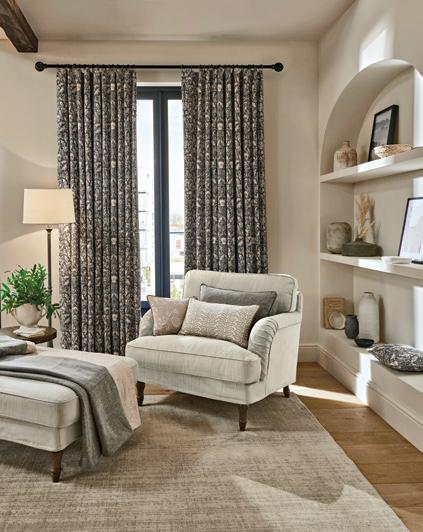
floral as your first pattern, the second could perhaps be a bold stripe or a geometric fretwork pattern, and then blend in another small-scale alternate geometric.
Consider adding another pattern or two, or three, if you wish; maybe a small check, a dot pattern is always favourable, or perhaps repeat with another stripe or floral. If you’re more adventurous, consider throwing an animal print into the mix for a bit of fun.
Balancing textures and fabric weight is also important to achieve a well-blended mix of fabrics, as is maintaining the same depth or magnitude of colour. By that, I mean if you’re working with primary colours, then try not to incorporate fabrics that are pastels, as you will inevitably create an imbalance.
When combining and layering patterns, it is important to balance the patterns throughout your space, the last thing you’ll want to do is create a situation where the heavier weight of patterns and colours are all at one end of the room. They should be well proportioned

with solids and any other visible patterns in your room, such as area rugs, wall coverings, fireplace surrounds to provide equilibrium and an aesthetically pleasing look. In addition, it’s important when pairing up your choices to consider the “feel” of the fabrics you’re selecting – for example, whether they are formal or more casual – and then maintain consistency.
Pattern blending can be fun, and these fabrics can create a bold statement in your home. Mixing fabrics like a pro is all about balance, layering and blending. When it’s done well, contrasting but complementary patterns and textures can elevate your space beyond the typical to a fresh, innovative and welcoming home. Toiles, stripes, florals, ikats and check are just some of the many different patterns we see, blend them with rich velvets, textural boucle, linens or silks to give your home that designer touch.
Just remember to keep a common element, and work with your scales and colours to see your home come alive.

Linda Mazur is an award-winning, nationally publicized designer and Principal of Linda Mazur Design Group. With almost two decades of experience this in demand multi-disciplinary design firm is known for creating relaxed, stylish spaces and full-scale design builds within Toronto, the GTA and throughout Canada. lindamazurdesign.com @LindaMazurGroup
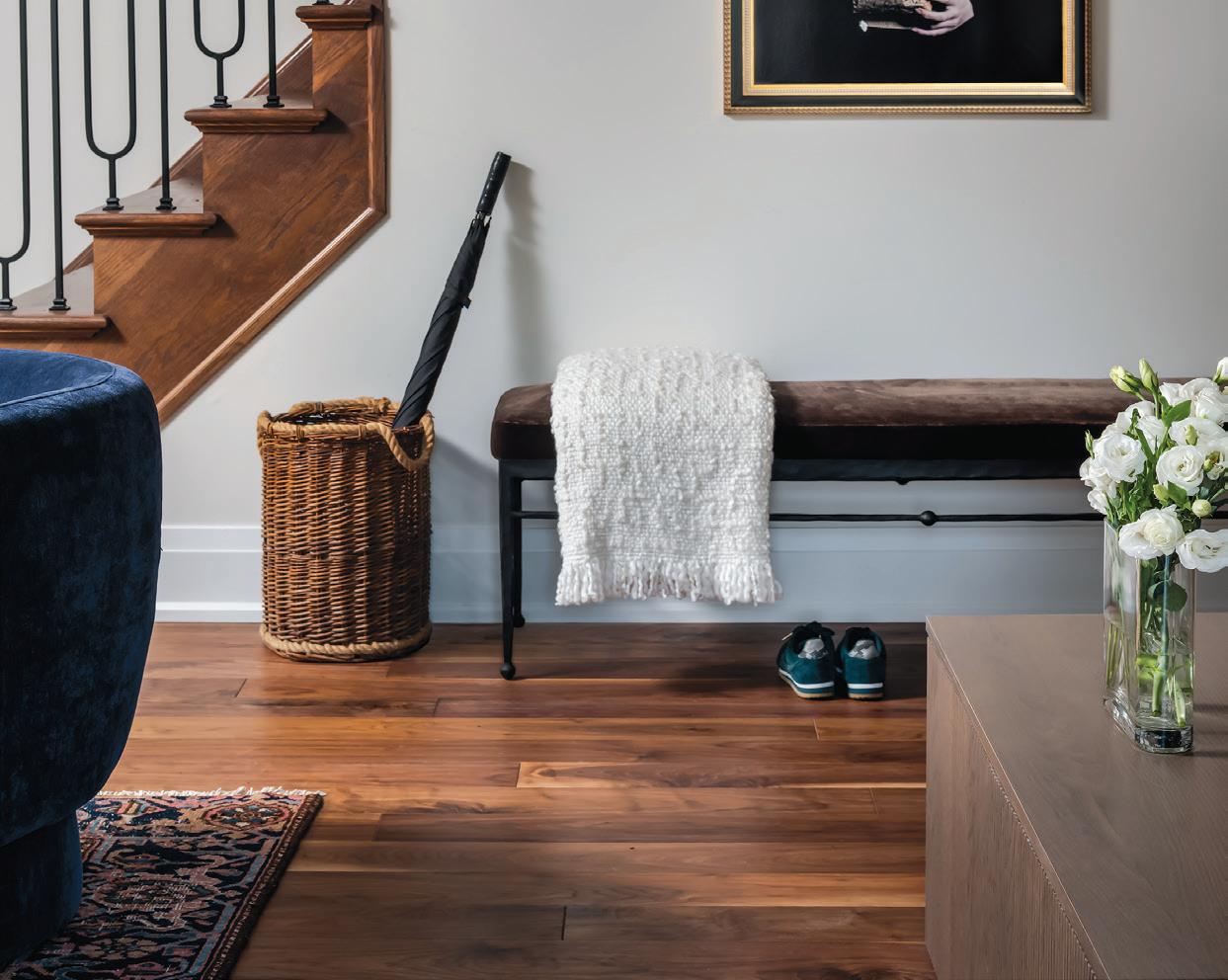
by MARIAM ABOUTAAM
When designing model home interiors, one of my top considerations is flooring. These homes will soon welcome real families, and I always keep those future residents in mind when selecting materials for each space.
In pre-construction communities, the flooring is often described in the schedule of finishes included in the purchase agreement. However, most builders offer a wide range of options and upgrades for homebuyers to
personalize their new home. In this way, model home designers become stand-ins for the future homeowner, making purposeful choices that reflect both style and function.
Once I’ve established the design theme, flooring and kitchen


cabinetry are next. Like many, I love the warmth and natural beauty of hardwood. I often select flooring that complements the colour and grain of the kitchen cabinetry. In open-concept layouts, matching the flooring stain to the staircase creates a seamless visual flow, something you’ll see in our Kylemore model homes.
Hardwood in the kitchen is a popular look, but moisture can be a concern. One design trick I’ve used successfully is to inset a “carpet” of tile between the island (with sink and dishwasher) and the cooktop. From the front, the tile is hidden, maintaining the


continuity of the hardwood while adding durability in high-use areas.
Throughout the home, ceramic, porcelain tile and vinyl are my go-to alternatives. In bathrooms, I prefer textured, non-slip tiles underfoot while reserving polished finishes for walls and shower enclosures. Often, tile suppliers offer multiple finishes with the same design, allowing for a cohesive look while reducing slip factors.
In one of our featured laundry rooms, I selected a two-by-eight-in. ceramic tile with an aged, textured finish and had it laid in a herringbone pattern. The result? A subtle nod to the charm of a heritage home.
Vinyl flooring has seen significant innovation over the past two decades.
I often choose it as a smart, stylish option for lower levels and high-traffic areas. With realistic wood textures and impressive durability, it’s a budgetfriendly alternative that doesn’t sacrifice style and can work well in many areas of the home.
Flooring plays an important role in how a home looks, feels and functions. From creating visual flow in openconcept spaces to ensuring durability in high-use areas, every choice is made with both design integrity and real-life living in mind. Whether it’s hardwood for warmth, tile for texture or vinyl for resilience, the right flooring enhances the design while supporting the way families really live.
In my next column, I’ll be exploring how lighting choices shape the mood, flow and functionality of every room.
An award-winning in-house designer, Mariam Aboutaam is Director, Sales and Marketing, Interior Design at Kylemore, Markham, Ont., a builder known for masterplanned communities and luxury homes. kylemoreliving.com.
The
1. Bristol place 199 Main St, North, Brampton
2. Duo condos Malta ave & Steeles Ave
3. Mayfield Collection 2256 Mayfield Road. Mayfieldcollection.ca
4. Curio Condos 801 The Queensway marlinspring.com
5. Humberwood Heights 50 Humberwood Blvd. tributecommunities.com
6. Arcadia District Bloor & Kipling arcadiadistrict.com
7. Kül Condos 875 The Queensway kulcondos.com
8. Panda Markham 8200 Warden Ave. lifetimedevelopments.com
9. Gallery Towers at Downtown Markahm 162 Enterprise Blvd. downtownmarkham.ca
10. Highmount 4077 Hwy. 7 highmountbykingdom.com
MISSISSAUGA
11. Birch at Lakeview Village Lakeshore & Dixie Rd. branthaven.com
12. Artform Condos 86 Dundas St. E. emblemdevcorp.com
13. Exhale Condominiums Lakeshore Rd. East & Dixie Rd. exhalelakeshore.ca
14. Westport 28 Ann Street westportcondos.ca
15. Central Park Sheppard Ave. East & Leslie St. amexon.com
16. Yonge City Square 4050 Yonge St. yongecitysquare.com
PICKERING
17. Vupoint Kingston Rd. & Liverpool Rd. tributecommunities.com
OSHAWA
18. U.C. Tower 2425 Simcoe St N,Oshawa tributecommunities.com
TORONTO
19. Lawrence Hill Urban Towns Don Mills & Lawrence lawrencehillurbantowns. com
20. 489 Wellington St. W. 489 Wellington St. W. lifetimedevelopments.com
21. 500 Dupont St. 500 Dupont St. lifetimedevelopments.com
22. Artistry Condos 292 Dundas St. W. tributeartistrycondos.ca
23. Panda Condos Yonge & Dundas. lifetimedevelopments.com
24. 36 Eglinton Ave. W. 36 Eglinton Ave. W. lifetimedevelopments.com
25. Linx Condominiums Danforth & Main tributecommunicties.com
26. Y&S Condos 2161 Yonge St. tributecommunities.com
27. 50 at Wellesley Station
50 Wellesley St. East pureplaza.com
28. No. 1 Yorkville 1 Yorkville Ave. pureplaza.com
29. Theatre District Residences Adelaide & Widmer pureplaza.com
30. Bijou on Bloor 2450 Bloor St. West pureplaza.com
31. The Briar on Avenue 368 Briar Hill Ave. pureplaza.com
32. One Seventy Spadina & Queen St. West pureplaza.com
33. King West & Charlotte King St. West & Charlotte pureplaza.com
34. Forest Hill Private Residences
2 Forest Hill Rd. foresthillresidences.com
35. Oscar Residences 500 Dupont St. W. at Bathurst oscarresidences.com
36. Kingside Residences Kingston Rd. & Danforth altreedevelopments.com
37. Allure Condominiums 250 King St. East emblemdevcorp.com
38. XO Condos King & Dufferin lifetimedevelopments.com
39. 225 Jarvis Street Condos Dundas St. East & Jarvis amexon.com
40. 101 Spadina Spadina & Adelaide 101spadina.com
41. The Residences of Central Park Sheppard Ave. East & Leslie centralparktoronto.com
42. The Dawes at Main Street Danforth & Main St. thedawes.com
43. Birchaus Birchcliffe Village on Kingston Road birchausresidences.com
44. Knotting Hill 4000 Eglington Ave. W knottinghillcondominiums. com
45. Park Avenue Place 1 & 2
Jane St. & Rutherford Rd. solmar.ca
The latest properties in the Southwestern Ontario Area to keep your
1. Affinity Condos Plains Rd. E. & Filmandale Rd. rosehavenhomes.com
2. Millcroft Towns Appleby Line & Taywood Dr. branthavenmillcroft.com
3. North Shore North Shore Blvd. & Plains Rd. nationalhomes.com
FORT ERIE
4. Discoverie Condos Signature Communities discoveriecondos.ca
HAMILTON
5. 1 Jarvis 1 Jarvis 1jarvis.com
6. The Design District 41 Wilson Street emblemdevcorp.com
7. Corktown 225 John Street South corktown.condos
NIAGARA
8. Lusso Urban Towns Martindale Rd. & Grapeview Dr. lucchettahomes.com
9. The Greenwich Condos at Oakvillage Trafalgar Rd. & Dundas branthaven.com
10. Synergy McCraney St. E. & Sixth Line branthaven.com
11. Upper West Side at Oakvillage 351 Dundas St. E. upperwestsidecondos2.ca
12. Greenwich Condos at Oakvilage Trafalgar Rd. & Dundas St. branthaven.com
13. Villages of Oakpark Dundas & Trafalgar ballantryhomes.com
STONEY CREEK
14. Casa Di Torre 980 Queenston Rd. branthaven.com
15. On The Ridge Lormont Blvd. & Chaumont Drive liveontheridge.ca

































































Often when homeowners decide to take on a renovation, it is a substantial investment in one of their largest assets – their home. One has only to read the news or chat with a friend to hear about a remodeling project gone wrong or a homeowner being taken advantage of by unscrupulous, fly-by-night operators masquerading as renovation professionals. This underscores why accreditation, validation and/or licensing of renovation professionals is crucial and something that BILD and Greater Toronto Area (GTA) RenoMark members support.
Earlier this year, the City of Toronto commenced a review of its rules for businesses and trades outlined in Toronto Municipal Code Chapter 545, Licensing (the licensing bylaw). Through this review, the City is considering deregulating certain business types and trades to modernize the licensing by-law to meet today’s business environment and reduce red tape, notably the building renovator license.
BILD, as an industry association representing not just builders and developers in the GTA, but also professional renovators, has provided its input into the review. First and foremost, our position remains that oversight and regulation are necessary in the renovation sector, particularly for consumer protection. However, does the administration
of this oversight need to be done by the City, or can it be completed more effectively and efficiently by another body?
For example, under the RenoMark program, established in 2001 by BILD and now operated nationally by the Canadian Home Builders’ Association (CHBA), participating renovators must comply with a series of requirements well beyond the City of Toronto’s licensing requirements. Under the RenoMark program in the GTA, participants are subject to a strict series of conditions to be part of the program. They must be verified annually to ensure they are WSIB enrolled, have valid insurance coverage for $2 million liability to protect the homeowner, provide a two-year warranty, use written contracts, and commit to high standards of customer service. They must adhere to BILD’s code of ethics and companion document, and the RenoMark Code of Conduct while also committing to continued education and training and they must have all required licenses and registrations. For GTA RenoMark renovators that also build entirely new custom homes, BILD verifies that they have a Home Construction Regulatory Authority license number.
GTA RenoMark participants must be members in good standing of BILD, the Ontario Home Builders’ Association, and CHBA. All of these elements are currently administered under RenoMark and offer an excellent opportunity to ensure renovators operating in the city of Toronto adhere to strict regulatory and customer service standards, and add no additional cost or

administrative requirements to the city.
Renovating your home is an exciting opportunity and one that all homeowners should undertake with confidence in the renovator who they have chosen. The City of Toronto and other municipalities across the GTA have an opportunity to ensure that homeowners can renovate with confidence. Licensing requirements are reviewed by partners; and programs such as Renomark should be considered the standard that all renovators must adhere to. This will assure higher levels of consumer protection and reduce administrative burden – a solution that benefits all.
Dave Wilkes is President and CEO of the Building Industry and Land Development Association (BILD), the voice of the homebuilding, land development and professional renovation industry in the GTA. For the latest industry news and new home data, follow BILD on Twitter, @bildgta or visit bildgta.ca.








